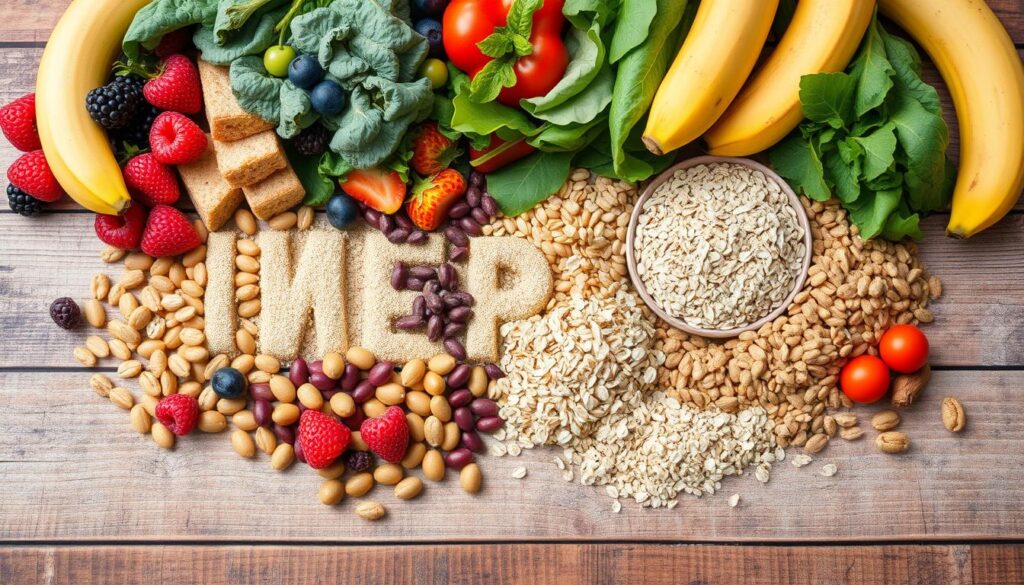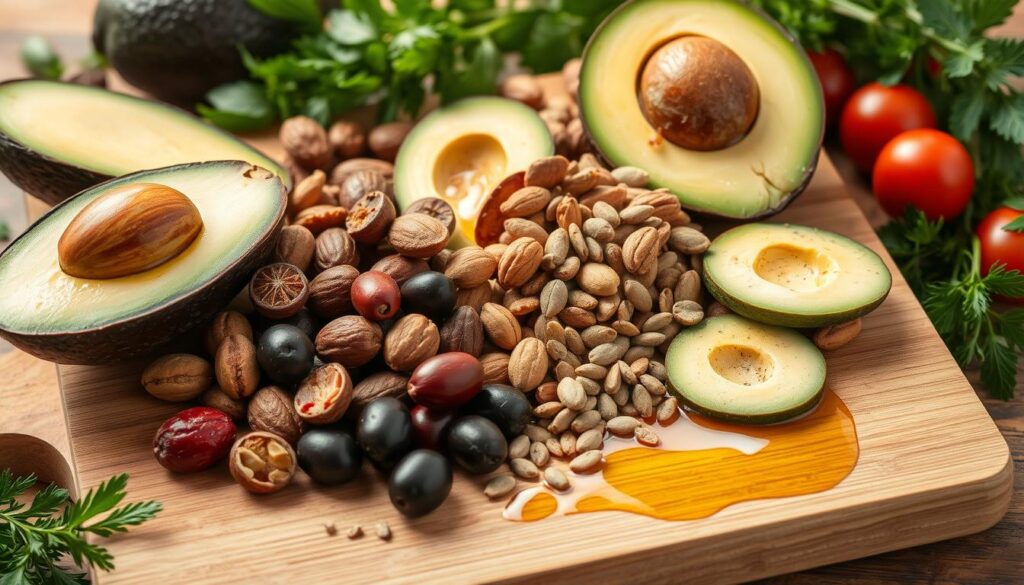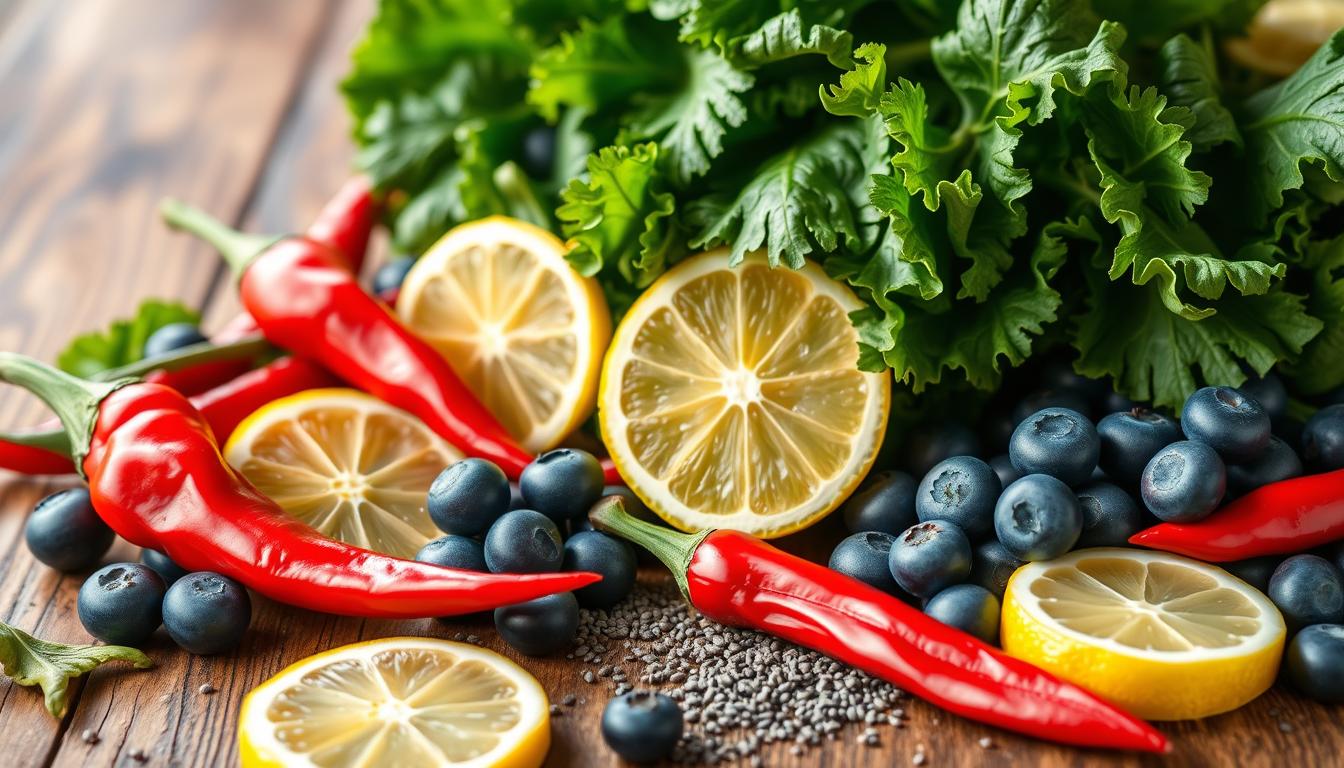Did you know that nearly 70% of Americans struggle with their weight? Incorporating fat burning foods into their diets could significantly help. This staggering statistic underscores the critical role our dietary choices play in achieving fitness goals. By integrating metabolism-boosting foods into your daily routine, you can enhance your body’s calorie-burning efficiency. This, in turn, supports long-term weight management.
This article delves into the essential information on top fat-burning ingredients and their role in boosting metabolism. We will explore the benefits of these foods, including tasty recipes and effective meal prep tips. Our focus is on sustainable changes and enjoyable eating, guiding you through effective strategies for leveraging these natural fat burners. Prepare to unlock the potential of fat burning foods and transform your approach to nutrition!
Key Takeaways
- Incorporating fat burning foods can significantly enhance metabolism.
- Top fat-burning ingredients provide energy and aid in weight management.
- Sustainable dietary changes can improve overall health and fitness.
- Simple meal prep tips make it easy to enjoy metabolism-boosting meals.
- Combining these foods with regular exercise maximizes results.
Understanding Fat Burning Foods
Exploring the realm of fat burning foods can profoundly impact your weight loss journey and overall health. These ingredients are pivotal in enhancing metabolic efficiency and facilitating fat reduction. Recognizing the most effective fat loss foods can revolutionize your meal plans, becoming a cornerstone of your nutritional approach.
What Are Fat Burning Foods?
Fat burning foods are distinct ingredients renowned for their metabolic support capabilities. They typically possess properties that augment thermogenesis, the bodily process of heat generation and calorie expenditure. Notable examples include:
- Green tea
- Lean proteins, like chicken and fish
- Spices, such as cayenne pepper
- Berries, rich in antioxidants
Integrating these fat-burning superfoods into your regimen can significantly enhance your body’s fat-burning prowess, fostering a more balanced lifestyle.
How They Help Metabolism
These weight loss-promoting foods elevate your metabolic rate, enabling your body to burn energy with greater efficiency. Research indicates that specific components can elevate metabolism by as much as 15%. By incorporating these foods into your daily intake, you not only facilitate fat loss but also experience enhanced energy levels, making physical activity more pleasurable.
Benefits of Including Fat Burning Foods
Incorporating fat burning foods into your diet can lead to numerous health benefits, particularly regarding weight loss and energy levels. These foods not only help shed extra pounds but also ensure sustained vitality throughout the day. A well-balanced diet that includes fat-burning snacks can make a significant difference in overall wellness.
Weight Loss and Maintenance
Fat burning foods play a crucial role in reaching and maintaining a healthy weight. Foods rich in protein and fiber, such as lean meats, beans, and vegetables, boost metabolism and promote feelings of fullness. Consuming these foods can lead to effective weight loss strategies. For instance, studies show that individuals who regularly include high-fiber foods in their diet tend to maintain their weight more effectively. This combination helps curb cravings and prevents overeating, making it easier to stick with a healthy lifestyle.
Improved Energy Levels
Another significant advantage of fat burning foods is the increase in energy levels. Foods like avocados and berries are not only tasty but also packed with essential nutrients. Incorporating these items as fat-burning snacks can help sustain energy levels throughout the day. Research has indicated that a diet high in antioxidants, found in fruits such as berries, enhances overall energy and decreases fatigue. Choosing the right fat burning foods can transform how you feel daily and help you stay active and engaged in various activities.
Top 10 Fat Burning Foods to Incorporate
Integrating the appropriate foods into your regimen is pivotal for weight reduction and the promotion of a healthier lifestyle. Identifying the most effective fat-burning ingredients can substantially elevate your metabolic rate. Below, we present the most efficacious foods for fat loss, designed to facilitate your journey.
1. Lean Proteins
Lean proteins, including chicken breast, turkey, and fish, are indispensable for muscle synthesis and repair. They contribute to satiety, thereby reducing caloric intake. Moreover, their thermic effect surpasses that of carbohydrates and fats, leading to increased caloric expenditure during digestion.
2. Green Tea
Renowned for its metabolism-enhancing properties, green tea is a treasure trove of antioxidants known as catechins. These compounds are instrumental in fat oxidation and augment energy expenditure. Incorporating green tea into your daily routine offers a delightful way to boost your metabolic rate.
3. Berries
Berries, encompassing blueberries, strawberries, and raspberries, are classified as fat-burning fruits. They are characterized by their low caloric content and high fiber density, effectively curbing cravings for sweet treats. Additionally, their antioxidant profile supports comprehensive health.
4. Avocados
Avocados are a goldmine of healthy fats, predominantly monounsaturated fats, which are conducive to fat loss. They induce satiety, facilitating hunger control throughout the day. The synergy of healthy fats and fiber positions avocados as an exemplary ingredient for various dishes.
How to Prepare Fat Burning Meals
Embarking on the journey to create delectable, nutrient-rich meals that aid in fat burning can be both straightforward and pleasurable. By embracing quick recipes, anyone can seamlessly integrate essential fat-burning ingredients into their daily diet. Moreover, meal prep with fat-burning foods ensures that wholesome options are perpetually accessible, rendering healthy eating a seamless endeavor.
Quick Recipes
These quick fat-burning meals present scrumptious avenues to energize your body efficiently:
- Spicy Veggie Stir-Fry: Sauté a medley of your preferred vegetables, such as bell peppers, broccoli, and carrots, in a scorching pan with olive oil and garlic. Introduce lean protein like chicken or tofu to enhance the meal’s satiety.
- Berry Smoothie: Blend spinach, a cup of mixed berries, Greek yogurt, and almond milk. This invigorating beverage is an ideal choice for breakfast or a midday snack, brimming with antioxidants.
- Quinoa Salad: Mix cooked quinoa with diced cucumbers, tomatoes, and chickpeas. Finish with a drizzle of olive oil and lemon juice for a revitalizing, fulfilling meal.
Meal Prep Tips
Adopting effective meal prep strategies can significantly reduce time spent on cooking and enhance the ease of maintaining a healthy diet:
- Outline your weekly meal plan. Identify the fat-burning recipes you intend to prepare to streamline your shopping list.
- Engage in bulk cooking. Prepare multiple servings of your preferred meals simultaneously, enabling you to freeze leftovers for future consumption.
- Employ transparent containers. Store prepped meals in clear containers for effortless access, aiding in portion control.
- Ensure variety. Alternate between different protein sources, vegetables, and grains to maintain the excitement and enjoyment of your meals.
Combining Fat Burning Foods with Exercise
The synergy between fat burning foods and a regular exercise regimen is paramount. Integrating the most effective fat loss foods into your pre- and post-workout diet can significantly elevate performance and recovery. Let’s delve into some exemplary choices.
Best Foods to Fuel Your Workout
Opting for the right fat-burning snacks before physical activity can dramatically elevate energy levels. Consider these options:
- Bananas: Rich in carbohydrates and potassium, they offer a swift energy surge.
- Greek Yogurt: This protein-dense snack facilitates muscle repair and satiety.
- Oatmeal: A prime source of complex carbohydrates, it maintains energy stability during exercise.
Recovery Foods
Post-exercise nutrition is equally vital. Consuming fat burning foods post-workout aids in replenishing energy and muscle recovery. Incorporate these into your diet:
- Quinoa: A complete protein that aids in muscle rebuilding and provides essential amino acids.
- Berries: Abundant in antioxidants, they help mitigate muscle inflammation.
- Almonds: An excellent source of healthy fats and proteins, ideal for muscle recovery.
Role of Spices in Fat Burning
Incorporating spices into your diet can significantly enhance the effectiveness of fat burning foods. Certain spices not only add flavor but also contribute to a faster metabolism. Cayenne pepper and cinnamon are notable examples, both gaining attention for their potential benefits.
Cayenne Pepper
Cayenne pepper contains capsaicin, a compound known for its heat and metabolism-boosting properties. Research indicates that capsaicin may help increase the metabolic rate, promoting calorie burning even after meals. You can easily include cayenne pepper in your diet by adding it to soups, stews, or sprinkling it on grilled vegetables to spice things up. Consider creating a spicy seasoning blend with cayenne to make healthy dishes more appealing.
Cinnamon
Cinnamon is another outstanding choice among spices for fat burning. This aromatic spice can assist in stabilizing blood sugar levels, which helps control cravings. Studies suggest that cinnamon may improve insulin sensitivity and increase metabolic responses. Try adding cinnamon to your oatmeal, smoothies, or even coffee for a delicious boost. With its sweet flavor, cinnamon can enhance various dishes while supporting your fat-burning goals.
Importance of Hydration
Hydration is a cornerstone of overall health, especially concerning its impact on metabolism. Adequate fluid intake boosts metabolic efficiency, facilitating better fat utilization and weight management. Water is essential for food breakdown, nutrient transport, and waste removal. Thus, the importance of water is critical for those seeking a healthier lifestyle.
Water and Metabolism
Optimal water consumption is crucial for metabolic function. Research indicates that sufficient hydration can temporarily elevate metabolic rates, aiding in fat burning and weight loss. A hydrated body operates more efficiently, facilitating optimal fat oxidation. To support both hydration and metabolism, aim for at least eight glasses of water daily.
Fat Burning Drinks
Integrating specific fat burning drinks into your regimen can enhance hydration and metabolism. Consider the following:
- Green tea: Rich in catechins, it boosts fat oxidation and calorie expenditure.
- Infused waters: Fruits or herbs add flavor and nutrients, enhancing hydration.
- Coconut water: Provides essential electrolytes, crucial for hydration post-workout.
Adopting these drinks daily highlights the importance of water while also advancing your hydration and fat burning objectives.
The Impact of Fiber-Rich Foods

Fiber-rich foods are pivotal in fostering fat loss and boosting digestive health. The inclusion of whole grains, legumes, and a diverse array of fruits and vegetables significantly enhances satiety and metabolic function. High-fiber diets are instrumental in effective weight management, making them a cornerstone of any regimen seeking a balanced lifestyle.
Whole Grains and Legumes
Whole grains, such as brown rice, quinoa, and oats, are paramount for their high fiber content. They contribute to sustained fullness and promote digestive health. Legumes, encompassing beans, lentils, and chickpeas, offer a rich blend of fiber and protein, forming a nutritious meal cornerstone. These foods are pivotal in weight loss endeavors, providing vital nutrients along the way.
Fruits and Vegetables
Fruits and vegetables are the bedrock of high-fiber diets. Varieties like apples, berries, carrots, and broccoli are rich in vitamins and fiber. Consuming a broad spectrum of these items ensures the body’s nutritional needs are met, aiding in hunger control. Incorporating more of these fiber-rich foods into daily intake can catalyze lasting weight loss and enhance overall health.
How to Avoid Common Myths
Many myths surround fat burning, confusing those aiming to boost their metabolism and reach weight loss goals. Grasping the truth can empower individuals to make better dietary choices. Let’s delve into prevalent misconceptions and what effectively aids in fat burning.
Debunking Fat Burning Myths
It’s common for people to believe that specific foods can magically burn fat. This belief is unfounded. Below are some common misconceptions about fat burning foods:
- Myth 1: Eating specific “fat-burning” foods alone will lead to weight loss.
- Myth 2: Skipping meals speeds up fat burning.
- Myth 3: Carbohydrates are always bad for fat loss.
These myths can lead to unsustainable dietary habits. It’s crucial to understand that successful weight management relies on a balanced diet and regular exercise, not just on a few supposed fat burning foods.
What Actually Works
Effective fat loss requires a holistic approach. Nutritionists and dietitians advocate for:
- Maintaining a calorie deficit through a balanced diet.
- Incorporating regular physical activity.
- Prioritizing whole foods over processed options for better metabolism support.
Embracing comprehensive lifestyle changes, rather than falling for fat burning myths, leads to lasting results. Education and awareness are key in combating misconceptions and adopting a healthier eating approach.
Balancing Fat Burning Foods with Other Food Groups
Creating a balanced diet necessitates the integration of various food groups, including those that facilitate fat burning. Recognizing the significance of whole foods can profoundly elevate nutritional intake. By blending whole foods with fat burning options, individuals can bolster their overall health and facilitate effective weight management.
Importance of Whole Foods
Whole foods are paramount as they deliver the essential nutrients that underpin bodily functions. They encompass fruits, vegetables, whole grains, and lean proteins, each contributing to a balanced diet. Incorporating these ingredients not only enhances fat burning but also enriches the dietary experience. Opting for whole foods over processed alternatives guarantees that the body receives vital vitamins and minerals, essential for peak performance.
Dietary Balance
Incorporating fat burning foods into meals can be both simple and gratifying. Here are some strategies for achieving dietary equilibrium:
- Pair leafy greens with grilled chicken for a protein-rich salad.
- Mix berries into oatmeal to enjoy a hearty breakfast.
- Combine avocado with whole grain toast for a nutritious snack.
- Include legumes in soups to boost fiber and protein content.
By adhering to this balanced approach, individuals can reap the advantages of fat burning foods while fulfilling their nutritional requirements. The essence lies in embracing the importance of whole foods to cultivate a healthier lifestyle.
Timing Your Fat Burning Meals
Optimal meal timing is pivotal for effective weight management and metabolism. Understanding how to time your meals can significantly enhance the benefits of fat burning foods. Correctly managing when you eat can help maximize the effectiveness of your exercise routine as well as promote healthy eating habits.
Eating Before and After Exercise
Timing meals for fat burning is essential, especially around your workout schedule. Consuming a small meal or snack rich in fat burning foods about 30 minutes to an hour before exercising can provide necessary energy. Foods like bananas or oatmeal with nuts are excellent choices for pre-workout nourishment. After exercising, it’s vital to replenish your body with protein and healthy fats. Consider options like a protein shake with berries or scrambled eggs with avocado.
Mindful Eating Practices
Incorporating mindful eating into your routine can enhance your relationship with food and improve your awareness of nutritional choices. Focus on your meals by eliminating distractions such as phones or television. Chew slowly, savoring each bite while paying attention to your body’s hunger cues. This practice can lead to better digestion and a greater appreciation for the fat burning foods you consume, fostering a healthier lifestyle.
The Role of Healthy Fats

Exploring the role of fats in diet often centers on the significance of healthy fats, essential for overall health. Despite common misconceptions, integrating healthy fats into one’s diet is crucial, particularly for those aiming to enhance fat burning. These fats contribute to increased satiety, better nutrient absorption, and metabolic support, all of which aid in weight loss.
Omega-3 Fatty Acids
Omega-3 fatty acids stand out as exemplary healthy fats. Present in fatty fish, walnuts, and flaxseeds, they bolster heart health and diminish inflammation. Research underscores their impact on fat metabolism, enhancing the body’s fat-burning capacity. Incorporating these into daily meals can significantly contribute to achieving health and wellness objectives.
Coconut Oil
Coconut oil is a remarkable source of healthy fats, rich in medium-chain triglycerides (MCTs). These are renowned for their energy-boosting properties and potential in fat loss. Recent studies indicate that MCTs elevate the body’s energy expenditure, crucial for weight management. Using coconut oil in cooking or as a dressing is a tasty method to add healthy fats to your diet.
Integrating these healthy fats supports a comprehensive nutritional strategy, aligning with those seeking to include fat burning foods. Learn more about the advantages of healthy fats and their potential to revolutionize your dietary habits by visiting this informative resource.
Supplements for Boosting Metabolism
In today’s quest for effective weight management, many individuals turn to supplements for weight loss. These products often claim to help in boosting metabolism and enhancing fat burning. Among the most discussed are various natural fat burners that find their way into the daily routines of fitness enthusiasts.
Natural Fat Burners
Natural fat burners can come in different forms and ingredients, offering a plethora of options for those aiming to support their weight loss journey. Some of the most popular natural fat burners include:
- Green Tea Extract – Known for its antioxidant properties and ability to enhance fat oxidation.
- Caffeine – A common stimulant that may help increase energy and promote fat utilization during exercise.
- Garcinia Cambogia – Extracted from a tropical fruit, it is often marketed for its potential to suppress appetite and block fat storage.
- CLA (Conjugated Linoleic Acid) – This fatty acid has shown promise in reducing body fat while preserving lean muscle mass.
Consultation with a Health Professional
Before incorporating any supplements into your regimen, it is crucial to consult with a health professional. Personalized advice ensures a focus on safe options that align with individual health needs. A healthcare provider can provide insights into:
- Potential interactions with medications.
- Your unique health conditions.
- Appropriate dosages for effective results.
Adapting Fat Burning Foods to Different Diets
Embarking on the journey to incorporate fat burning foods into your regimen can be a transformative experience. The plethora of dietary adaptations available today necessitates an exploration into how these ingredients align with various eating paradigms. This discourse will focus on specific diets, including the paleo regimen and vegan alternatives, presenting meal concepts that integrate fat-burning components.
Paleo Diet
The paleo diet champions whole, unprocessed foods, drawing inspiration from our ancestral dietary habits. This framework naturally harmonizes with numerous fat burning foods. Consider integrating the following into your diet:
- Lean meats such as turkey, chicken, and grass-fed beef
- Fatty fish like salmon and mackerel for healthy omega-3s
- Healthy fats from avocado, olive oil, and nuts
- Seasonal fruits and colorful vegetables
For a rapid and satisfying meal, prepare a salad with diced chicken, mixed greens, avocado, and olive oil dressing. This combination fosters satiety and aids in fat burning.
Vegan Options
Plant-based diets also abound with fat burning foods, catering to diverse dietary preferences. Vegans can indulge in a variety of options, including:
- Chickpeas and lentils as protein-rich staples
- Quinoa and bulgur for whole grain options
- Leafy greens like kale and spinach packed with nutrients
- Nuts and seeds, including chia seeds and almonds
Consider a quinoa bowl with black beans, diced bell peppers, corn, and avocado for a delectable vegan meal. This dish, rich in fat-burning properties, is entirely plant-based.
Success Stories: Real-Life Examples
Many individuals have undergone transformative changes by integrating fat burning foods into their diets. These narratives serve as powerful reminders of the potential for positive transformation. They detail the journeys of those who have successfully shed pounds and enhanced their health through informed dietary choices. Insights from experts offer invaluable guidance for those contemplating embarking on their own transformative path.
How Fat Burning Foods Made a Difference
A significant number of individuals have discovered the advantages of fat burning foods. For example, one person shed over 30 pounds by substituting processed snacks with nuts and berries. These foods, rich in fiber and healthy fats, induce a sense of satiety while controlling calorie intake. Another account showcases a group’s success with lean proteins, such as chicken and fish, which boosted their metabolic rates effectively.
Tips from Experts
Nutritionists and health professionals provide insightful advice on incorporating fat burning foods into daily life. Here are some of their expert tips for weight loss:
- Prioritize whole, nutrient-rich foods over heavily processed options.
- Stay hydrated with water and fat burning drinks like green tea.
- Incorporate a variety of fruits and vegetables to maximize fiber intake.
- Plan meals to include lean proteins combined with fat burning foods for balanced nutrition.
- Listen to your body’s hunger cues and practice mindful eating.
Final Thoughts: Making Fat Burning Foods a Lifestyle
Adopting fat-burning foods into your daily regimen transcends a fleeting trend, evolving into a lifestyle that fosters enduring health and vigor. Success hinges on a steadfast commitment to dietary consistency. This dedication unlocks a plethora of advantages, including enhanced energy levels and effective weight management.
Consistency is Key
Adhering to your objectives can prove daunting, yet embracing a regimen of healthy eating over time yields substantial outcomes. Consider the benefits of meal planning and preparation, which can streamline your journey. Every incremental change, when integrated into your routine, can catalyze profound transformations. Embrace the journey, and let it motivate you to explore an array of recipes and ingredients.
Enjoying Your Fat Burning Journey
The pleasure derived from discovering delectable, wholesome dishes is invaluable. Delight in the exploration of diverse culinary experiences, allowing for the creation of flavorful dishes that align with your health goals. For additional insights into nutritious choices, refer to this article on fat-burning foods. The essence of this journey lies not solely in the destination but in the relished moments leading to your wellness goals.

